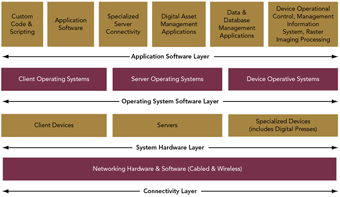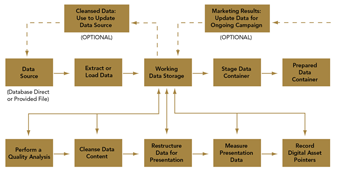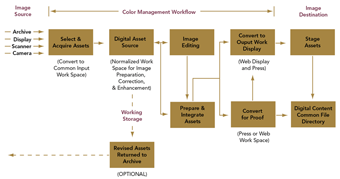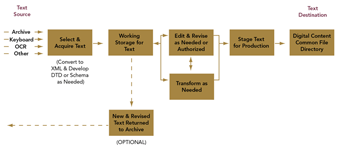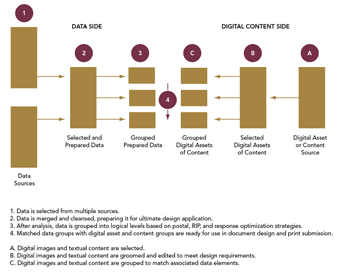By Franziska Frey, Ph.D. and Nicholas D. Barzelay
While variable data printing is widely recognized as an important adjunct to customer relationship management and targeted marketing, complexities with data and digital content preparation have limited the actual application of the technology. Digital assets and data involve processes closely associated with information technology. Lack of information technology savvy is reflected in how data is handled, what tools are used, and what skills are fostered to work the tools.
The purpose of this month’s research monograph, a literature review entitled Upstream Database and Digital Asset Management in Variable Data Printing (PICRM-2008-01), by Franziska Frey, Ph.D., RIT School of Print Media McGhee Distinguished Professor, and Nicholas Barzelay, RIT School of Print Media adjunct professor, is to understand the application of database and digital asset management tools, techniques, and skills to facilitate content preparation for variable data printing jobs. It does not address who is responsible for addressing the data and digital asset components in the overall workflow – the customer or the service supplier.
Background Theory
Effective VDP is based on three key elements: the physical computing system (the system model), information structure (the information model), and design configurations for different VDP types (basic VDP models).
System Model
The basic system architecture supporting VDP is multi-layered, as shown in Figure 1. Primary layers, from the bottom up, concern connectivity, hardware, system software, and application software.
Figure 1. Basic system architecture
click to view image full size
Data and digital content sources may include mainframe systems, minicomputers, or servers of varying power. Client-server architecture is generally multi-tiered, spreading selective functionality across different platforms or processors. DAM capabilities can reside on a different server than the database management system, though this is not a necessity. The two content sources feed a large storage-capacity workstation, which may be used for both data preparation and document design.
The VDP system is facilitated by a local area network (LAN), which requires networking skills in addition to application and data handling skills. Networking is limited to connecting the proofing printer, the workstation, and the digital front end (DFE) of the digital press or high-speed ink jet printer. Customer-supplied data may eliminate some complexity, because the customer is responsible for assembling data and content. The customer, not the printer, has to deal with IT infrastructure. But this means that the printer has to assume the data is clean, organized, and usable – a potential risk for both the customer and the printer. The provided data and content may or may not reflect the customer’s business or campaign objectives. It may be nothing but a mailing list of unknown quality from some commercial source. Whatever the source and whatever the content, the immediate need is to understand it, determine its level of quality, and then deal with it. This means that it is necessary to have some capabilities and facilities for examining the data and other content (digital images and potentially text), which can be very time-consuming.
Information Model
Information may consist of data in the form of facts or figures, digital content such as text, images, and photographs, or metadata (data about data). Information modeling is building information structures by categorizing, grouping, and organizing data elements for effective and meaningful accessibility – usually in the form of a tree of some type. It can be as common as preparing a report, or as esoteric as creating an object-relational database with XML (eXtensible Markup Language) components.
VDP Models
Data-Driven Print: Strategy and Implementation lists six types of variable printing: versioning, mail merge, personalized printing, transaction printing, Internet-on-demand, and fully customized communications.
Each of the six types is detailed below:
Versioning. An example of this would be mail order catalogs being prepared for different areas of the country. The variability would be in the catalog content.
Mail merge. An example of this is a mailing campaign using letters printed on an offset press. The letters would then be addressed in a second run on a digital press. Addressing could also be completed in-line with a high-speed ink jet print head.
Personalized printing. An example of this would be individual store advertisements with coupons that are prepared for each customer based on their buying habits.
Transactional printing. An example of this would be individual monthly investment reports that were prepared based on month-end status and the past month’s account activity for each investor.
Internet-on-demand. There are several approaches to this type of solution. One approach is to use the Internet as the request medium for a common print-on-demand (POD) solution. Another approach is using the Internet as the distribution vehicle for a standard advertisement prepared at corporate offices. The advertisement would be sent over the Internet to product distributors who customize the document to reflect their distributorship and, potentially, tailor it for their individual customers as well.
Fully customized communications. This is the most complex type of VDP. An example is an automobile dealer who sends out advertisements about the new model year to current customers. The content would reflect the age of their current automobile, its color, model, accessories, and remaining lease or payment amount. The advertisement would contain an offer for a new car purchase, showing pictures of the new vehicle with interior and exterior pictures that match the customer’s tastes.
Data-Driven Workflows
There are three basic workflows that need to be addressed for VDP: data, images, and text. These are discussed below.
Data Preparation
Data drives VDP quality and affects results. Given the potential scope of problems and applied solutions, and considering the likely large number of records or rows in the dataset, a considerable amount of functionality is needed to manipulate and structure the data for successful VDP production. The data preparation workflow is illustrated in Figure 2.
Figure 2. Data preparation workflow
click to view image full size
This is not a workflow to delay until data and document design are merged. The activities that compromise the data preparation workflow are significant. Data acquisition processes involve more than just getting the data:
- Capture or load
- Transform, organize, and store in a standard storage format
- Eliminate superfluous data
- Administer or manage, providing security and recoverability
The objective is to ultimately work with a single set of data, but the data may come from multiple sources or reside in multiple datasets that present integration issues.
Digital Image Preparation
Digital assets are usually prepared in a design, pre-media, prepress sequence. VDP presents an additional issue because images are manipulated and placed on documents according to business logic based on a data stream. Therefore, digital images should be prepared iteratively and in parallel with data. Digital image preparation, illustrated in Figure 3, can be very complex in terms of the types of issues encountered and the “repair work” potentially needed. The workflow is similar to that for data, but is further complicated by color management requirements to ensure desired colors at press-time.
Figure 3. Digital image preparation workflow
click to view image full size
Problems requiring digital content preparation may have a variety of causes, but usually relate to embedded color profiles, embedded fonts, copyrighted fonts and images, file formats, file sizes, and assumptions about appropriate color space. Images that have already been processed as a result of artistic work may still require corrective action to make them usable and/or the desired results achievable.
Digital Text Preparation
Further complicating content preparation is the need to deal with the digital text assets, which may have their own unique, processing requirements such as XML-based content. A text-based workflow is pictured in Figure 4.
Figure 4. Digital text preparation workflow
click to view image full size
Digital asset preparation that addresses textual content issues is relatively simple, although it can be time-consuming when reviewing text and making necessary corrections or when structured and tagged text components such as XML are involved. Editorial and technical functions that check accuracy, appropriateness, and wording, spelling, grammar, and punctuation, formatting and capitalization, and compliance with XML structure and process conventions are all necessary.
Putting It All Together
Once data and digital assets have been prepared and moved into a production staging area for data and digital assets, they need to be synchronized. If they were already synchronized during a prior step, then the synchronization needs to be validated. The choreography of data and digital assets (shown in Figure 5) can be complex. Potential benefits need to be researched and quantified.
Figure 5. Data and digital content choreography
click to view image full size
Conclusions
A VDP solution requires the interplay of topical knowledge about business and marketing, information content (data and images), and printing applications across the entire print production workflow from inception to delivery. All these topics come into play at conception, and continue to operate together iteratively over the life of the project. Design concept, knowledge acquisition from data, and graphics modify each other as a design emerges.
It does not matter who is responsible for addressing the data and digital asset components in the overall workflow, be it the customer or the service supplier. It only matters that the work is done in conjunction at the proper time. This requirement presents an opportunity for the service supplier to expand the range of services offered, the duration of service delivery, and the degree to which the customer relationship can be enhanced.
Constraining the number of tools involved and using the right tools in the right sequence not only streamlines VDP processing, it makes finding the right skill combination simpler. It also simplifies the need to keep technical experts up-to-date with rapidly advancing technologies. The following is a preliminary list of skills needed to adequately support VDP solution delivery:
- Information, knowledge, and application architecture skills
- Networking and systems integration skills
- Business and requirements analysis skills
- Imaging, color management, and DAM skills
- Text manipulation processing skills (including XML and Perl)
- Desktop or server database administration, design, and SQL programming skills
- General object-oriented design and programming skills using compiled and interpreted languages
- Web design and cross-media development skills (including XHTML, CSS, and scripting)
2007-2008 Research Monographs:
To read about this research in detail, download the monograph from: http://print.rit.edu/pubs/picrm200801.pdf
This article from the Printing Industry Center at RIT was originally published in the Centers affiliate-only eReview newsletter. Article Series Index.

